Working State of ECC Link Slabs Used in Continuous Bridge Decks
Abstract
1. Introduction
2. The Structural Working State Theory
2.1. Mathematical Modeling for the Structural Working State
2.2. Detection of the Structural Working State Characteristics
3. Experimental Program
3.1. Preparation of ECC and Mechanical Properties
3.2. Experimental Continuous Bridge Deck Models
3.3. Loading Procedure and Measuring Scheme
4. Experimental Data Expansion Using the Response Simulating Interpolation Method
- Divide the area into a certain amount of suitable elements as shown in Figure 5. Although the shape function of each element is estimated, the simulated strain fields assembled with enough small elements can still reflect the strain characteristics of this area exactly with high order continuity. The reason is that the calculation of element stiffness matrices and the assembling of global stiffness equation are based on the virtual displacement principle and the force balance principle, respectively [41].
- Apply a unit strain at node 1 along the direction at right angle to this area, while the other nodes are fixed along the same direction to restrict rigid body displacement. Then, the simulated strain field solved by static finite element analysis represents the shape function N1, as shown in Figure 6. And it can be expressed by discrete vector N1 = {N1 (1), N1 (2), …, N1 (k), …, N1 (n)}, where N1 (k) is the function value at element node k and n is the total node number.
- Other NSFs (Ni) can be determined in the same way. Given the strain value at each measuring point and the corresponding NSF, the strain field of this area denoted by ε = {ε (1), ε (2), …, ε (n)} can be constructed as following,where m is the number of measured points of strain. The constructed strain field conforming to Castigliano’s theorem is independent of loading paths and linear superposition can be applied to the simulated results with explicit physi-cal meanings.
5. Characterization of the ECC Link Slabs’ Working State
5.1. The GSED-Based Investigation into the Working States of ECC Link Slabs
- The elastic stage. As shown in Figure 9, the Ej,norm grows quite slowly and the developing trend is steady before M1, representing a stable stage of ECC link slabs under the simulated traffic loading. Actually, the working behavior within this stage is mostly the elastic response of ECC material properties and cracking was not observed during this period [26]. When the magnitude of load is relatively small, the structural load-bearing capacity is mainly offered by the ECC. The effect of FRP composites is not obvious as the GSED sum of the three ECC link slabs are almost identical in the early phase. The experimental structures are of adequate stiffness and stability within this stage.
- The elastic-plastic stage. The Ej,norm after M1 is relatively greater than that in the elastic stage as shown in Figure 9, speculating on the formation of micro-cracks and crack propagation afterwards. The Ej,norm-Lj curve in this stage is not that smooth due to the multiple cracking behavior of ECC materials [26]. The whole structure has transited into the elastic-plastic stage with local plastic development. It could be comprehended that the critical point M1 between elastic stage and elastic-plastic stage is the yielding point of each ECC link slab, where the working state changes from elasticity to elastoplasticity. The plastic behavior occurs at the 9th loading step for Type I and II ECC link slabs, and the 24th step for Type III ECC link slab. Accordingly, the yielding loads of the three types of ECC link slabs are 9 kN, 9 kN, and 24 kN, respectively. The CFRP bar reinforcement condition raises the yielding load of ECC link slab by 166.67%. Although Type I and Type II ECC link slabs yield to the same magnitude of load, the Ej,norm of the latter is relatively slow to reach M2. Compared with Type I ECC link slab, ECC link slab strengthened by CFT is observed to produce an extended elastic-plastic period. The structural toughness index T is proposed herein to quantify the energy dissipation capacity of ECC link slab working in the elastic-plastic stage, which is formulated as following:where EM1,norm and EM2,norm are the GSED sum at the loading steps corresponding to M1 and M2, respectively; S is the span of elastic-plastic stage (the difference in loading steps between M1 and M2). The results are illustrated in Figure 10 and it is evident that Type II ECC link slab exhibits superior structural toughness to Type I ECC link slab. The structural toughness index is raised by 78.79% owing to the CFT grid reinforcement, which could be attributed to the enhanced deformation capacity and cracking resistance.
- The degrading stage. Despite the presence of plastic behavior in some parts of link slabs, the whole structures are able to bear increasing loads until M2. The Ej,norm of Type I and Type II ECC link slabs begin to increase rapidly and sharply at M2 as shown in Figure 9, implying that the whole structures qualitatively leap to a new stage different from the previous ones. The number of cracks remained unchanged while the crack width and extent of cracking kept increasing [26]. It demonstrates that the ECC materials did not exhibit strain hardening characteristics and multiple cracking behavior any more. Moreover, forces cannot effectively be transferred between ECC and CFT grid after M2. The loss in normal properties of materials leads to the degrading structural performance within this stage. Therefore, the load corresponding to the critical point M2 can be defined as the structural failure load of the link slab. Actually, this updated failure is the initiation of structural performance deterioration (i.e., the initial structural failure), which is different from the existing structural ultimate failure. From this critical point on, the interfacial bonding between components and structural integrity start to be gradually impaired. This updated concept of failure is reliable as it is revealed by delving into the structural working state characteristics complying with the natural course from quantitative change to qualitative change. It is noted that the critical point M2 is not observed for Type III ECC link slab based on the existing test data. In other words, the degrading stage discussed herein is not applicable to Type III ECC link slab. Both the high flexural stiffness of CFRP bars and their intact bonding with ECC materials help to maintain the desired load capacity and ductility after M1 [26]. The development of local plastic deformation in Type III ECC link slab was far from enough to affect the working behavior of the whole structure, hence the initial failure point has not been reached in this investigation. Provided that the time-varying test data is complete, the initial structural failure load can be accurately predicted for Type III ECC links slab.
5.2. Working State Modes Based on Strains and Displacements
5.3. Characteristics of Structural Strain Fields
5.4. Development of Structural Internal Forces
6. Conclusions
- Advanced mathematical modeling technique based on the GSED for characterizing the working states of ECC link slabs was used successfully and structural working state leaps could be identified by the M-K criterion. Meanwhile, these leap features were verified by the strain/displacement-based working state modes, as well as the development of structural strain fields and internal forces. The working state leaps complying with the natural course from quantitative change to qualitative change indicate the essential evolution of structural performance governed by the material attributes.
- It was revealed that Type I and Type II ECC link slabs working through the whole loading process had three different working stages with two critical points, i.e., the yielding point and the initial structural failure point. The yielding point is a transition of structural working state between being elastic and elastic-plastic. The ECC link slabs working in the elastic-plastic stage could still withstand increasing loads despite the growth of cracks. The initial structural failure point is the origin of structural performance deterioration and ECC link slabs rapidly became closer to the ultimate failure from this point on.
- Type II and Type III ECC link slabs benefitted more than Type I ECC link slab from the FRP reinforcements. The remarkable rise in yielding load (166.67%) was obtained from ECC link slab incorporating CFRP bars and the structural toughness index was raised by 78.79% owing to the CFT grid reinforcement.
- In summary, the investigation on ECC link slabs’ working states explores a new way to structural analysis and the information involved in working state can make important contributions to the improvement of structural design.
Author Contributions
Funding
Acknowledgments
Conflicts of Interest
References
- Chen, B.; Zhuang, Y.; Briseghella, B. Jointless Bridges; Communications Press: Beijing, China, 2013. (In Chinese) [Google Scholar]
- Alampalli, S.; Yannotti, A.P. In-service performance of integral bridges and jointless decks. Transp. Res. Rec. J. Transp. Res. Board 1998, 1624, 1–7. [Google Scholar] [CrossRef]
- Au, A.; Lam, C.; Au, J.; Tharmabala, B. Eliminating deck joints using debonded link slabs: Research and field tests in ontario. J. Bridge Eng. 2013, 18, 768–778. [Google Scholar] [CrossRef]
- Caner, A. Behavior and design of link slabs for jointless bridge decks. PCI J. 1998, 43, 68–81. [Google Scholar] [CrossRef]
- Hou, M.; Hu, K.; Yu, J.; Dong, S.; Xu, S. Experimental study on ultra-high ductility cementitious composites applied to link slabs for jointless bridge decks. Compos. Struct. 2018, 204, 167–177. [Google Scholar] [CrossRef]
- Li, V.C.; Wu, H.C. Micromechanics based design for pseudo strain-hardening in cementitious composites. In Proceedings of the 9th Conference on Engineering Mechanics, College Station, TX, USA, 24–27 May 1992. [Google Scholar]
- Maalej, M.; Hashida, T.; Li, V.C. Effect of fiber volume fraction on the off-crack-plane fracture energy in strain-hardening engineered cementitious composites. J. Am. Ceram. Soc. 1995, 78, 3369–3375. [Google Scholar] [CrossRef]
- Zhong, J.; Shi, J.; Shen, J.; Zhou, G.; Wang, Z. Engineering properties of engineered cementitious composite and multi-response optimization using PCA-based Taguchi method. Materials 2019, 12, 2402. [Google Scholar] [CrossRef]
- Sahmaran, M.; Li, M.; Li, V.C. Transport properties of engineered cementitious composites under chloride exposure. ACI Mater. J. 2007, 104, 604–611. [Google Scholar] [CrossRef]
- Zhong, J.; Shi, J.; Shen, J.; Zhou, G.; Wang, Z. Investigation on the failure behavior of engineered cementitious composites under freeze-thaw cycles. Materials 2019, 12, 1808. [Google Scholar] [CrossRef]
- Maalej, M.; Quek, S.T.; Ahmed, S.F.U.; Zhang, J.; Lin, V.W.J.; Leong, K.S. Review of potential structural applications of hybrid fiber engineered cementitious composites. Constr. Build. Mater. 2012, 36, 216–227. [Google Scholar] [CrossRef]
- Choi, W.C.; Yun, H.D.; Cho, C.G.; Feo, L. Attempts to apply high performance fiber-reinforced cement composite (HPFRCC) to infrastructures in South Korea. Compos. Struct. 2014, 109, 211–223. [Google Scholar] [CrossRef]
- Zhang, J.; Maalej, M.; Quek, S.T. Performance of hybrid-fiber ECC blast/shelter panels subjected to drop weight impact. J. Mater. Civ. Eng. 2007, 19, 855–863. [Google Scholar] [CrossRef]
- Cho, C.G.; Kim, Y.Y.; Feo, L.; Hui, D. Cyclic responses of reinforced concrete composite columns strengthened in the plastic hinge region by HPFRC mortar. Compos. Struct. 2012, 94, 2246–2253. [Google Scholar] [CrossRef]
- Maalej, M.; Chhoa, C.Y.; Quek, S.T. Effect of cracking, corrosion and repair on the frequency response of RC beams. Constr. Build. Mater. 2010, 24, 719–731. [Google Scholar] [CrossRef]
- Mihashi, H.; Ahmed, S.F.U.; Kobayakawa, A. Corrosion of reinforcing steel in fiber reinforced cementitious composites. J. Adv. Concr. Technol. 2011, 9, 159–167. [Google Scholar] [CrossRef]
- Li, V.C. Integrated structures and materials design. Mater. Struct. 2007, 40, 387–396. [Google Scholar] [CrossRef]
- Kim, Y.Y.; Fischer, G.; Li, V.C. Performance of bridge deck link slabs designed with ductile engineered cementitious composite. ACI Struct. J. 2004, 101, 792–801. [Google Scholar] [CrossRef]
- Wing, K.M.; Kowalsky, M.J. Behavior, analysis, and design of an instrumented link slab bridge. J. Bridge Eng. 2005, 10, 331–344. [Google Scholar] [CrossRef]
- Li, V.C.; Lepech, M. Field demonstration of durable link slabs for jointless bridge decks based on strain-hardening cementitious composites. In Michigan Department of Transportation Research Report RC 1471; Michigan Department of Transportation: Lansing, MI, USA, 2005. [Google Scholar]
- Lepech, M.D.; Li, V.C. Application of ECC for bridge deck link slabs. Mater. Struct. 2009, 42, 1185–1195. [Google Scholar] [CrossRef]
- Benmokrane, B.; El-Salakawy, E.; El-Ragaby, A.; Lackey, T. Designing and testing of concrete bridge decks reinforced with glass FRP bars. J. Bridge Eng. 2006, 11, 217–229. [Google Scholar] [CrossRef]
- El-Salakawy, E.; Benmokrane, B.; El-Ragaby, A.; Nadeau, D. Field investigation on the first bridge deck slab reinforced with glass FRP bars constructed in Canada. J. Compos. Constr. 2005, 9, 470–479. [Google Scholar] [CrossRef]
- Zheng, Y.; Zhang, L.; Xia, L. Investigation of the behaviour of flexible and ductile ECC link slab reinforced with FRP. Constr. Build. Mater. 2018, 166, 694–711. [Google Scholar] [CrossRef]
- Berg, A.C.; Bank, L.C.; Oliva, M.G.; Russell, J.S. Construction and cost analysis of an FRP reinforced concrete bridge deck. Constr. Build. Mater. 2006, 20, 515–526. [Google Scholar] [CrossRef]
- Zhang, L. Investigation of the Behaviour of Fibre Reinforced Polymer (FRP) Reinforced Engineered Cementious Composites (ECC) Link Slab in Bridge Deck Structures. Master’s Thesis, South China University of Technology, Guangdong, China, 2017. (In Chinese). [Google Scholar]
- Zhou, G.; Rafiq, M.Y.; Bugmann, G.; Easterbrook, D.J. Cellular automata model for predicting the failure pattern of laterally loaded masonry wall panels. J. Comput. Civ. Eng. 2006, 20, 400–409. [Google Scholar] [CrossRef]
- Zhou, G.; Pan, D.; Xu, X.; Rafiq, Y.M. Innovative ANN technique for predicting failure/Cracking load of masonry wall panel under lateral load. J. Comput. Civ. Eng. 2010, 24, 377–387. [Google Scholar] [CrossRef]
- Zhang, Y.; Zhou, G.; Xiong, Y.; Rafiq, M.Y. Techniques for predicting cracking pattern of masonry wallet using artificial neural networks and cellular automata. J. Comput. Civ. Eng. 2010, 24, 161–172. [Google Scholar] [CrossRef]
- Huang, Y.; Zhang, Y.; Zhang, M.; Zhou, G. Method for predicting the failure load of masonry wall panels based on generalized strain-energy density. J. Eng. Mech. 2014, 140, 04014061:1–04014061:6. [Google Scholar] [CrossRef]
- Chattopadhyay, G.; Chakraborthy, P.; Chattopadhyay, S. Mann-Kendall trend analysis of tropospheric ozone and its modeling using ARIMA. Theor. Appl. Climatol. 2012, 110, 321–328. [Google Scholar] [CrossRef]
- Rehman, S. Long-term wind speed analysis and detection of its trends using Mann-Kendall test and linear regression method. Arab. J. Sci. Eng. 2013, 38, 421–437. [Google Scholar] [CrossRef]
- Hamed, K.H. Exact distribution of the Mann-Kendall trend test statistic for persistent data. J. Hydrol. 2009, 365, 86–94. [Google Scholar] [CrossRef]
- Mann, H.B. Nonparametric tests against trend. Econometrica 1945, 13, 245–259. [Google Scholar] [CrossRef]
- Kendall, M.G.; Jean, D.G. Rank Correlation Methods; Oxford University Press: New York, NY, USA, 1990. [Google Scholar]
- Hirsch, R.M.; Slack, J.R.; Smith, R.A. Techniques of trend analysis for monthly water quality data. Water Resour. Res. 1982, 18, 107–121. [Google Scholar] [CrossRef]
- Li, J.; Heap, A.D. Spatial interpolation methods applied in the environmental sciences: A review. Environ. Model. Softw. 2014, 53, 173–189. [Google Scholar] [CrossRef]
- Luo, W.; Taylor, M.C.; Parker, S.R. A comparison of spatial interpolation methods to estimate continuous wind speed surfaces using irregularly distributed data from England and Wales. Int. J. Climatol. 2008, 28, 947–959. [Google Scholar] [CrossRef]
- Shi, J.; Zheng, K.; Tan, Y.; Yang, K.; Zhou, G. Response simulating interpolation methods for expanding experimental data based on numerical shape functions. Comput. Struct. 2019, 218, 1–8. [Google Scholar] [CrossRef]
- Hauser, C.; Walz, B.; Maincon, P.; Barnardo, C. Application of inverse FEM to earth pressure estimation. Finite Elem. Anal. Des. 2008, 44, 705–714. [Google Scholar] [CrossRef]
- Zienkiewicz, O.C.; Taylor, R.L.; Zhu, J.Z. The Finite Element Method: Its Basis and Fundamentals, 7th ed.; Butterworth-Heinemann: Oxford, UK, 2013. [Google Scholar]
- Maalej, M.; Li, V.C. Flexural tensile-strength ratio in engineered cementitious composites. J. Mater. Civ. Eng. 1994, 6, 513–528. [Google Scholar] [CrossRef]
- Tran, M.T.; Vu, X.H.; Ferrier, E. Experimental and analytical analysis of the effect of fibre treatment on the thermomechanical behaviour of continuous carbon textile subjected to simultaneous elevated temperature and uniaxial tensile loadings. Constr. Build. Mater. 2018, 183, 32–45. [Google Scholar] [CrossRef]
- Soric, Z.; Kisicek, T.; Galic, J. Deflections of concrete beams reinforced with FRP bars. Mater. Struct. 2010, 43, 73–90. [Google Scholar] [CrossRef]
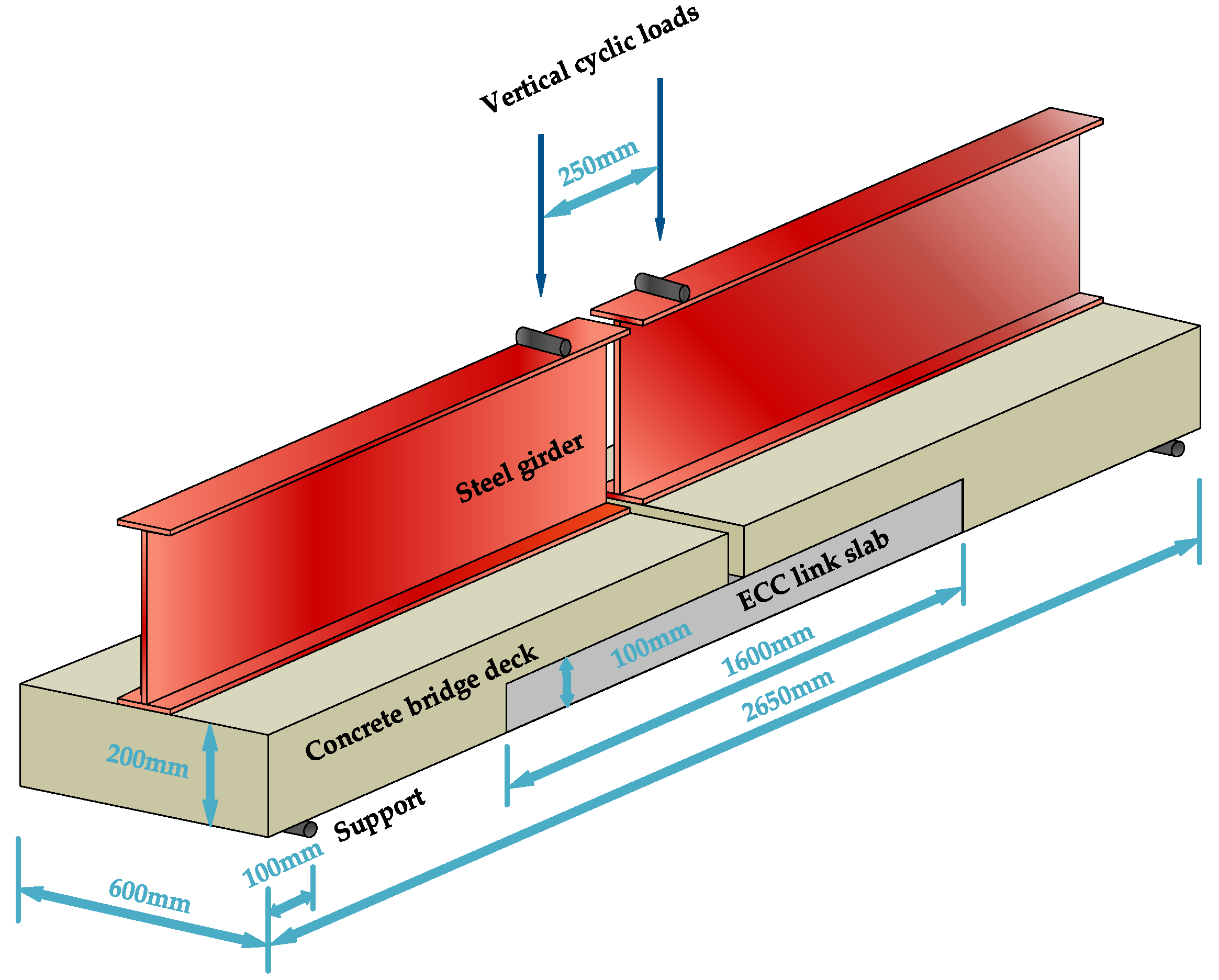
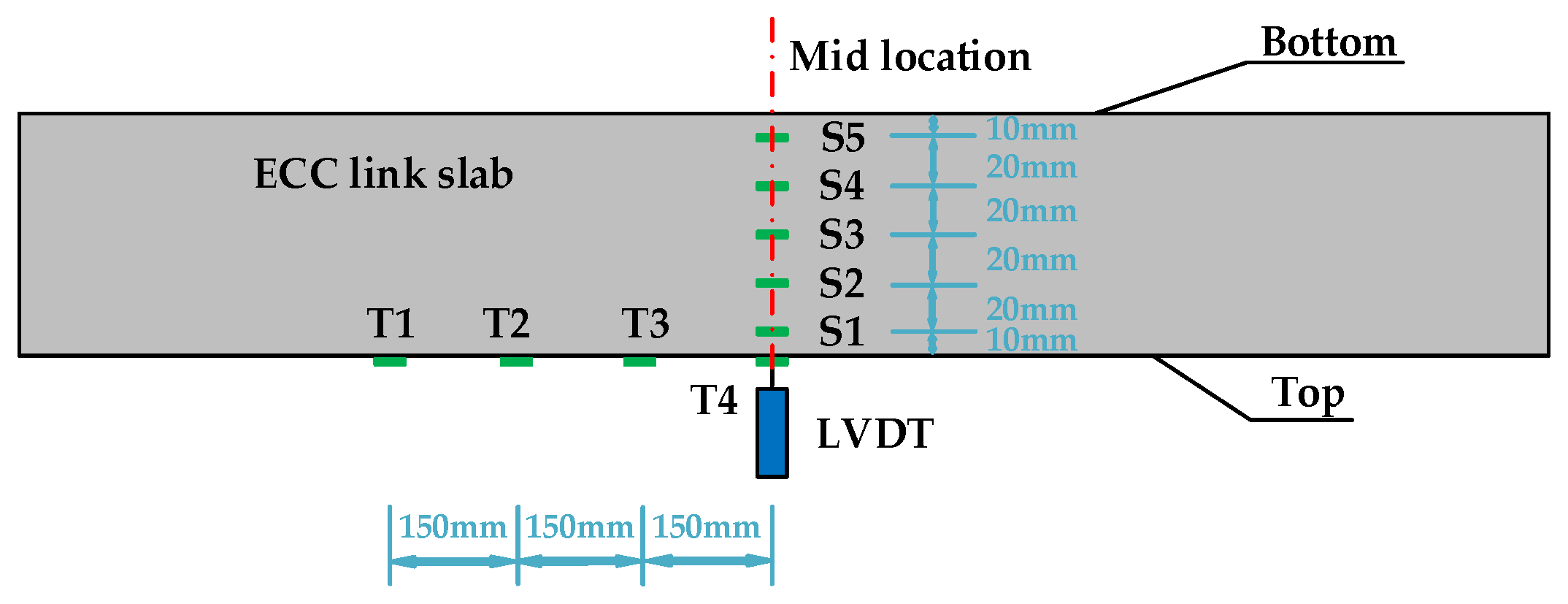

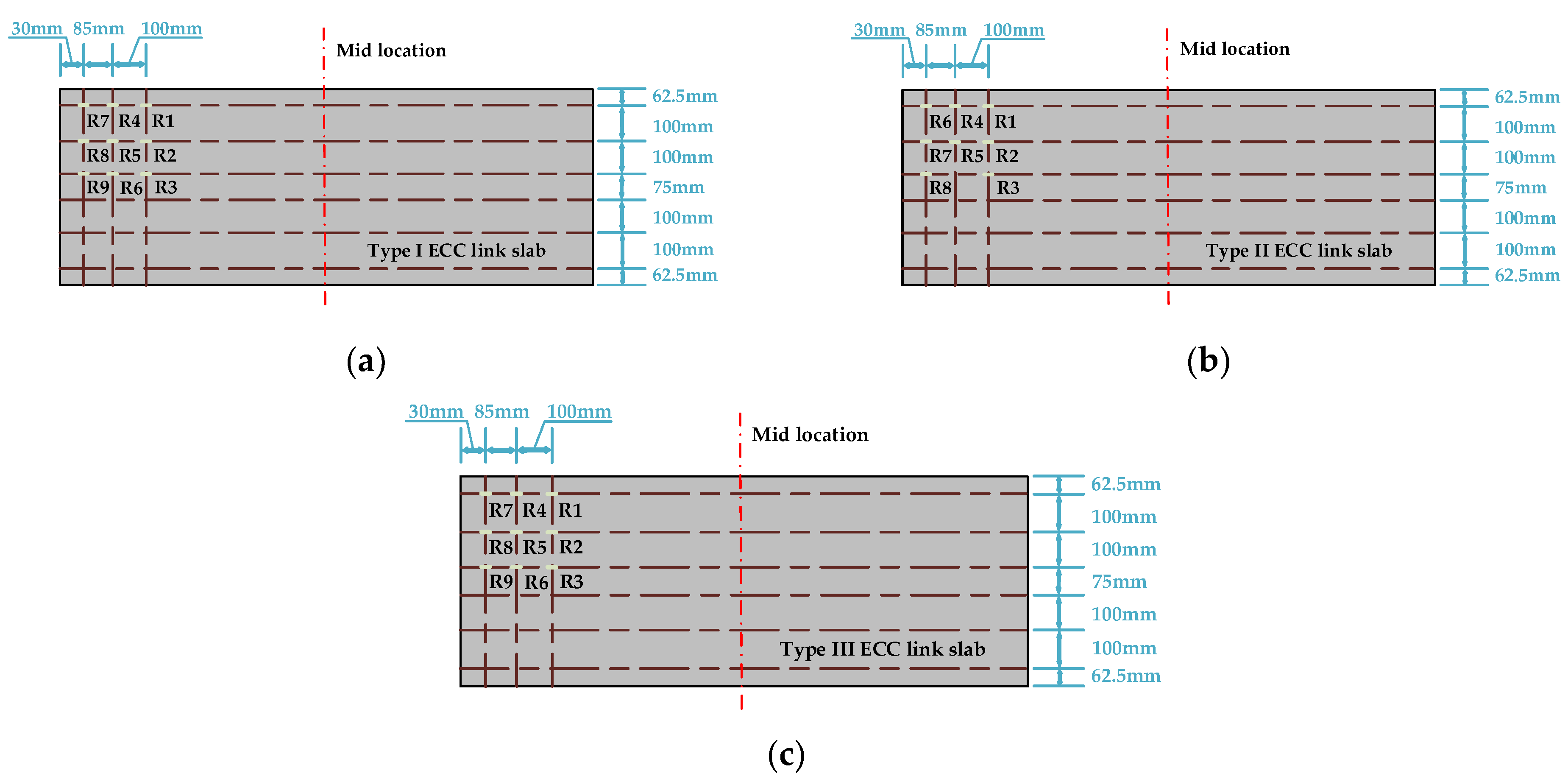


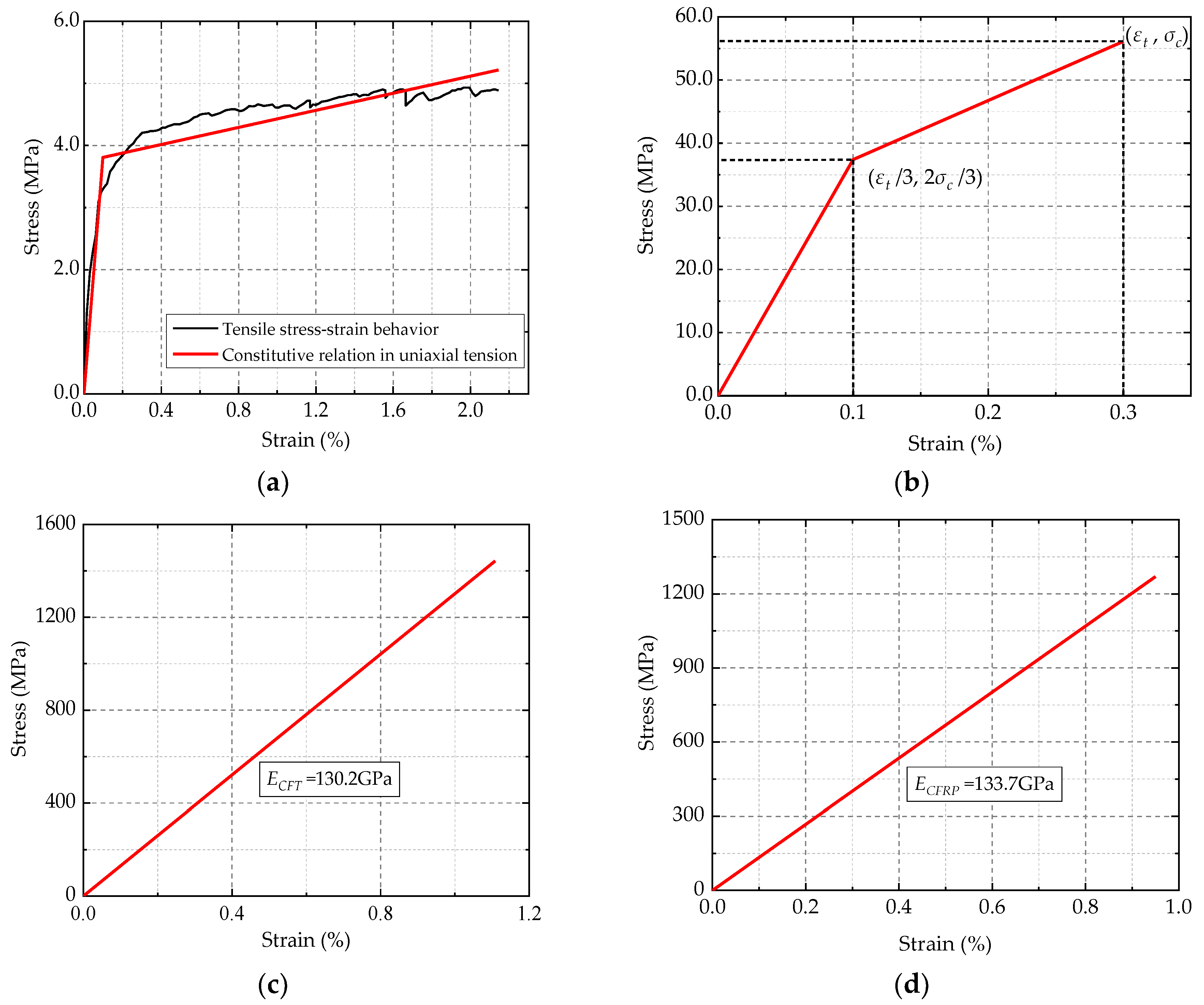
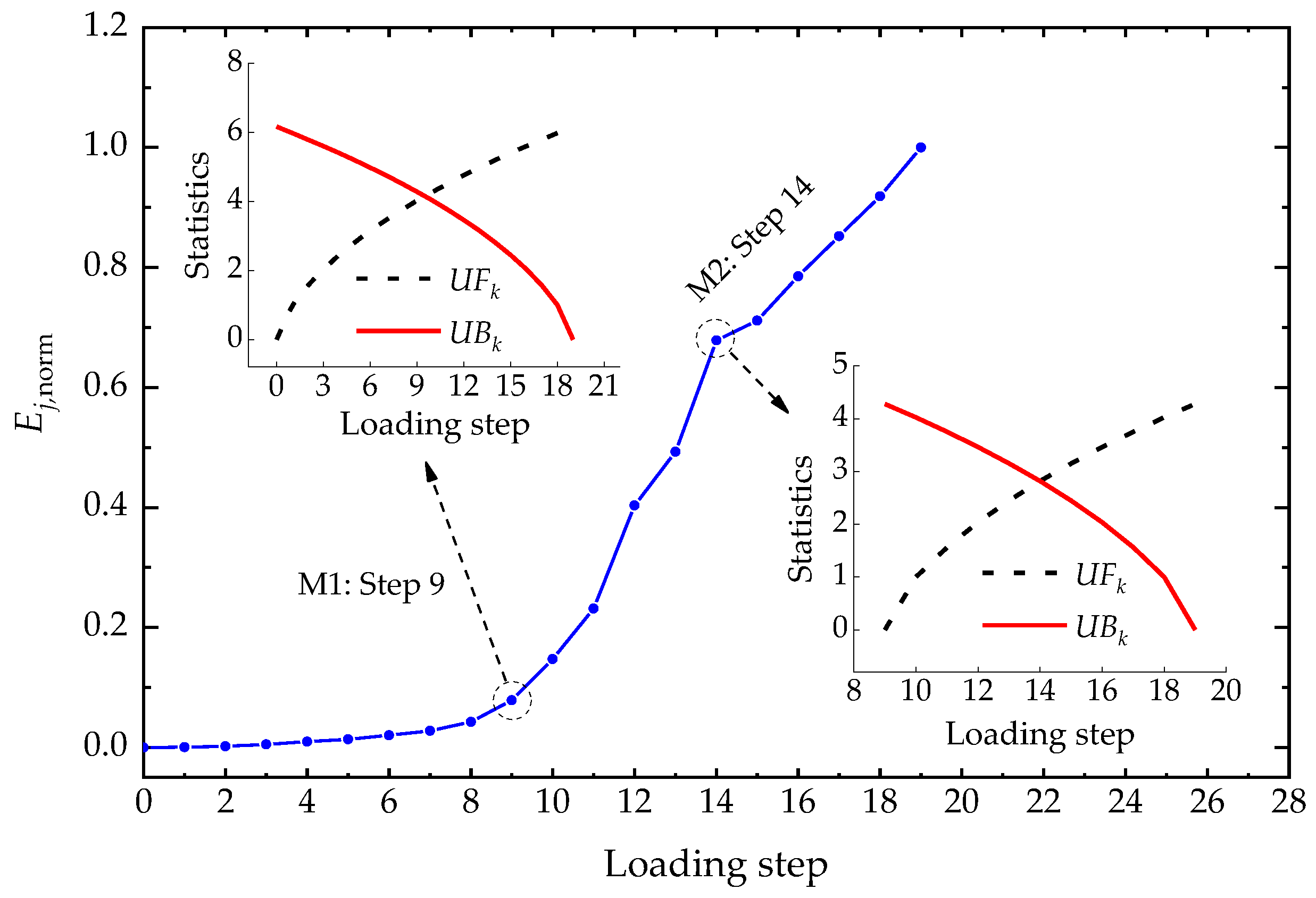

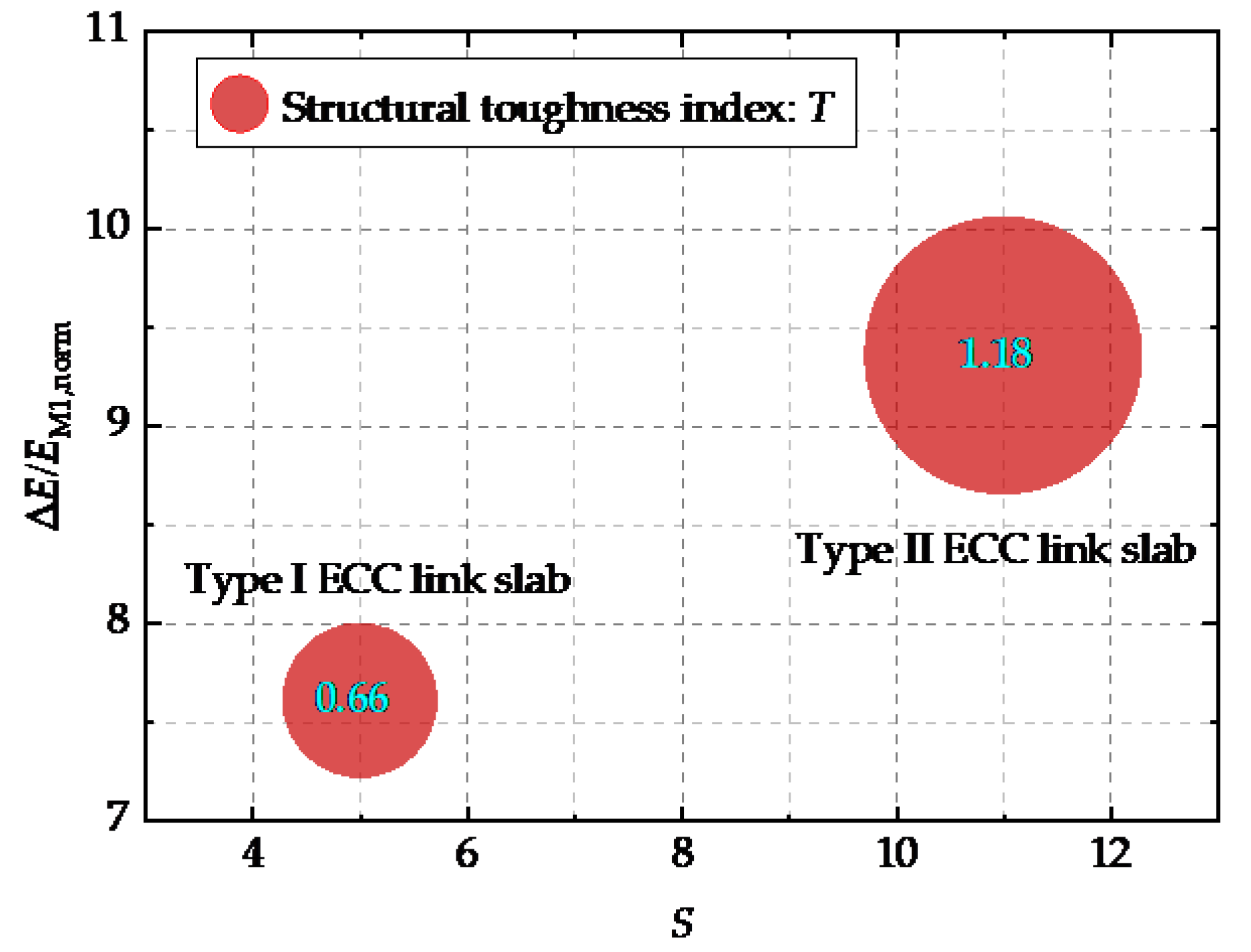
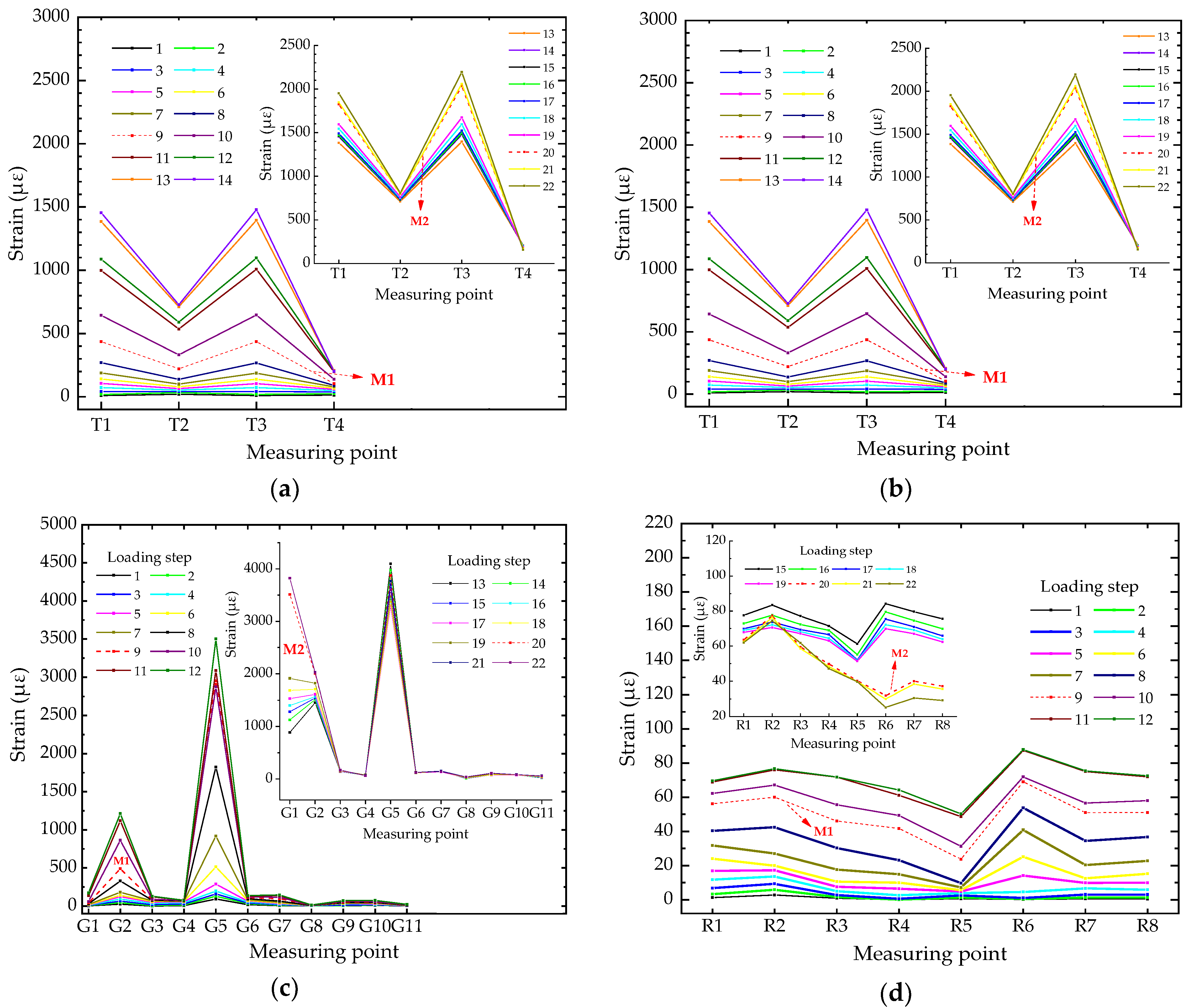
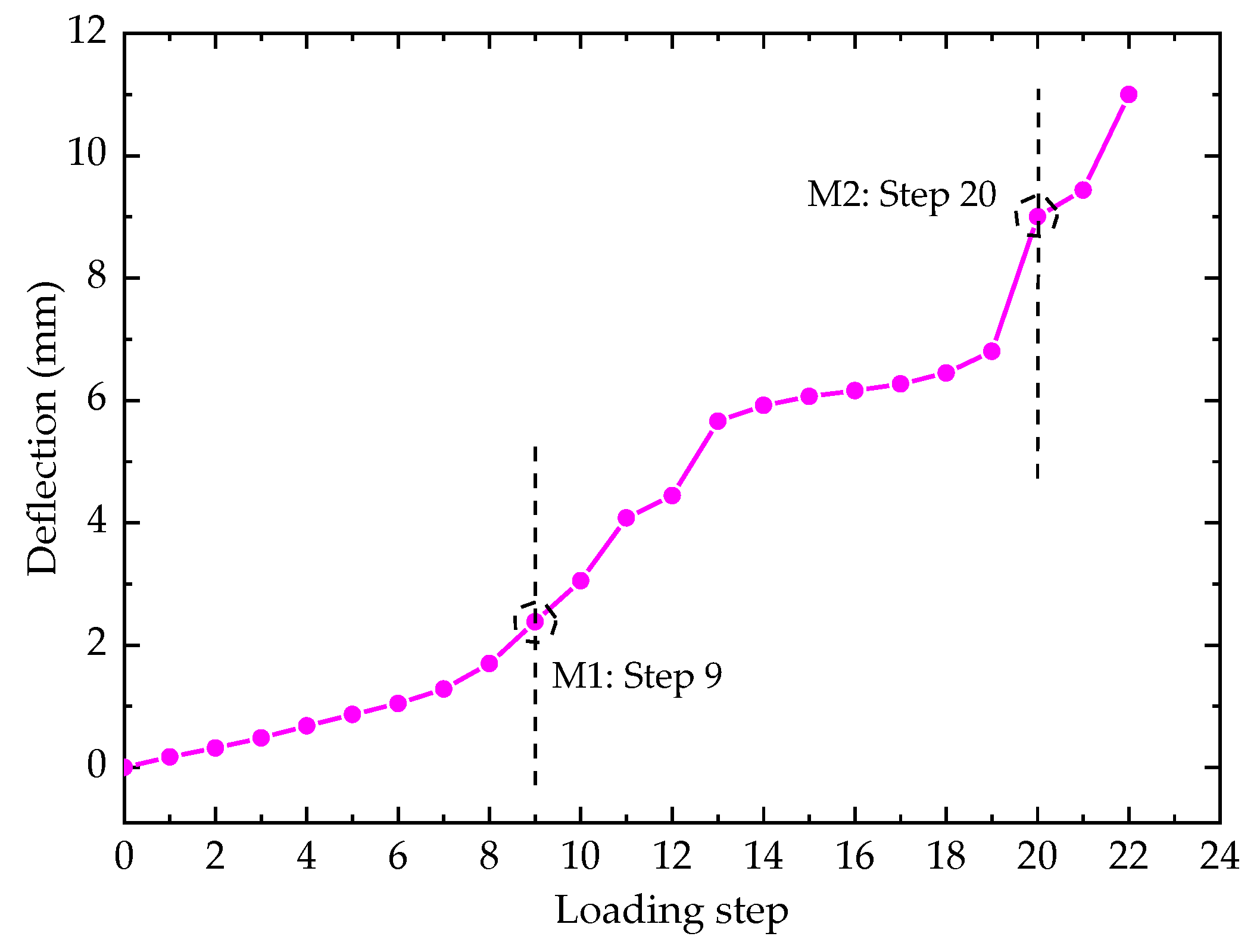
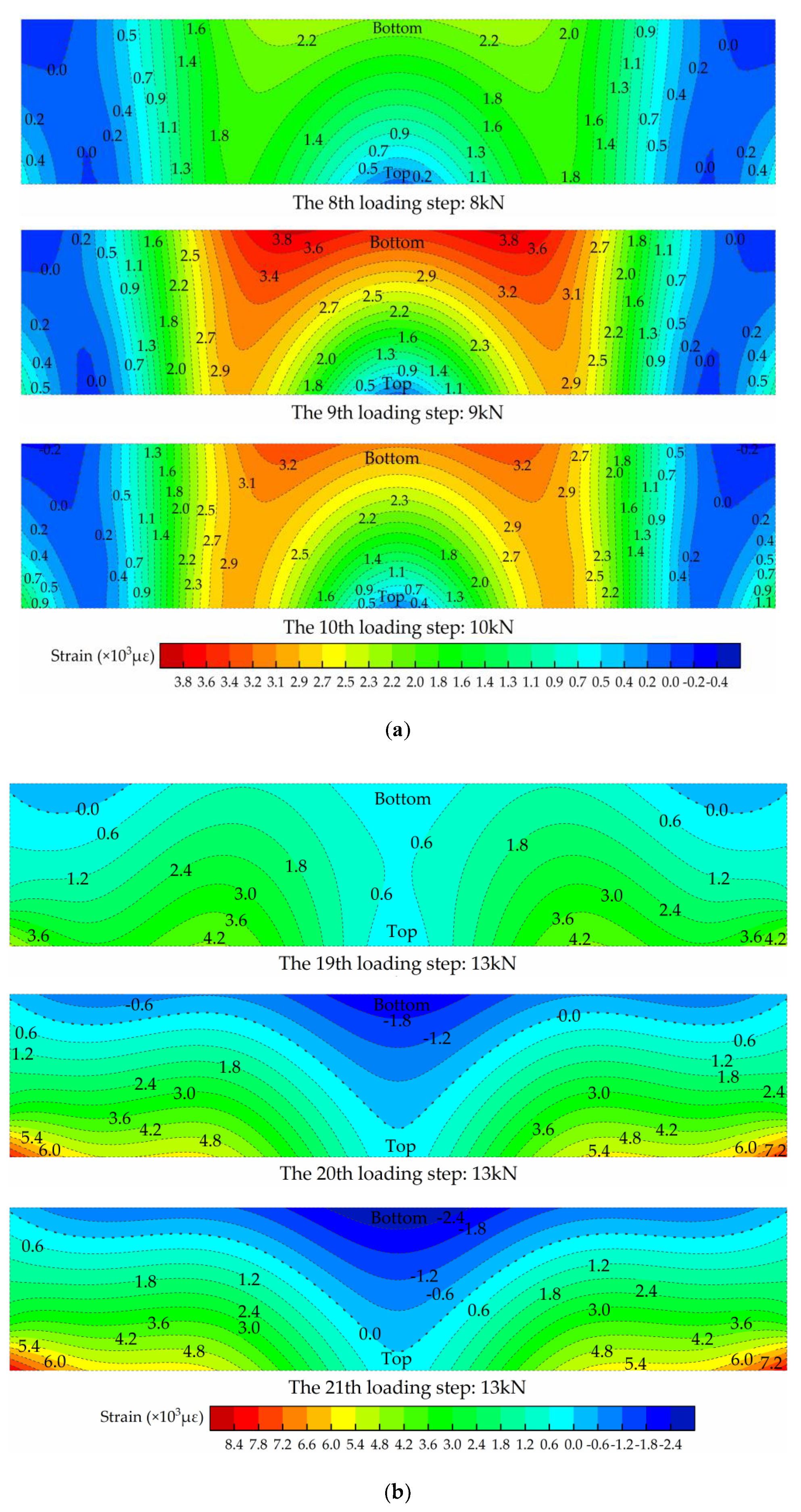
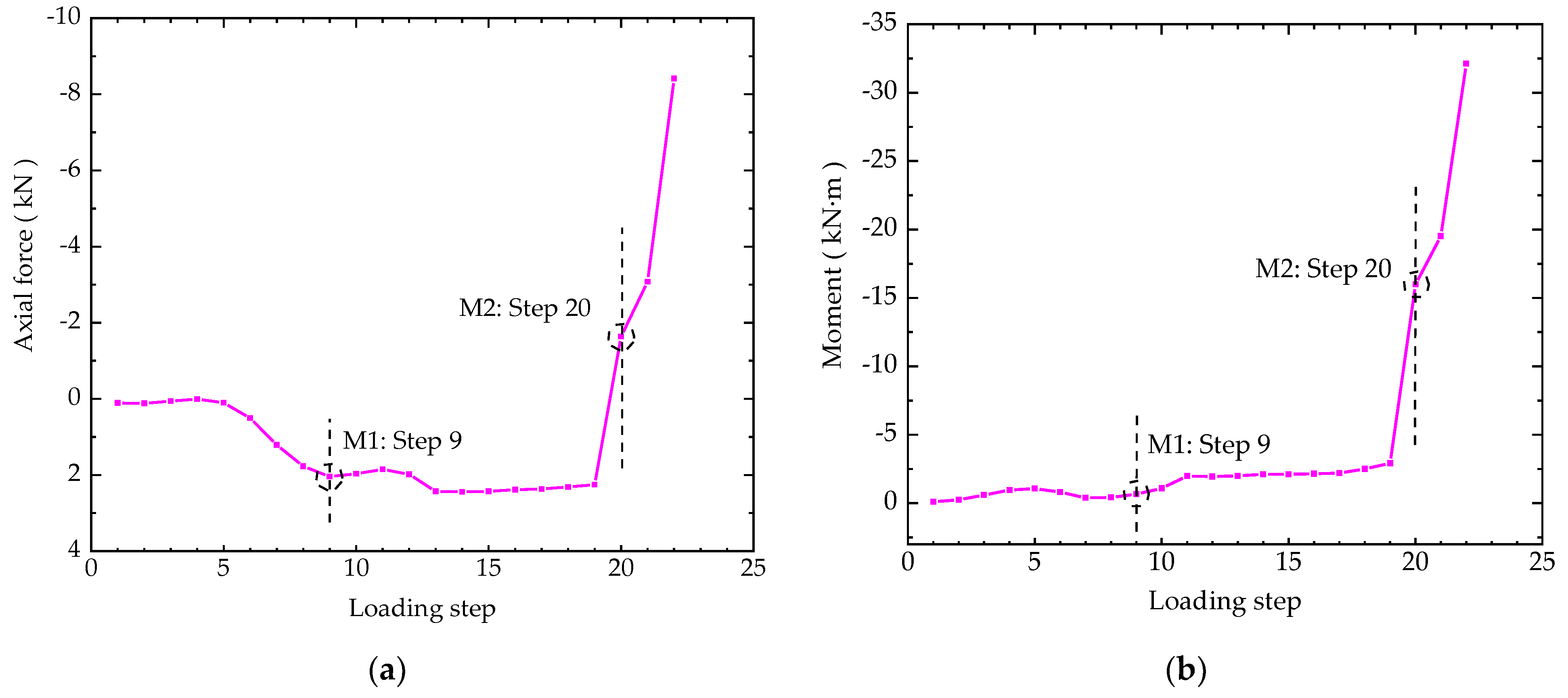
| Binder (wt. %) | W/B | S/B | VPVA | Superplasti-Cizer (wt. %) | ||||
|---|---|---|---|---|---|---|---|---|
| Cement | Fly Ash | Limestone Powder | Meta-Kaolin | Micro Silica fume | ||||
| 40 | 50 | 4 | 4 | 2 | 0.268 | 0.364 | 2.0 | 0.1 |
| Specimen | Compressive Strength (σc, MPa) | Compressive Strain (εc, %) | Tensile Strength (ft, MPa) | Tensile Strain (εt, %) |
|---|---|---|---|---|
| ECC | 56.12 | 0.3 | 4.96 | 2.29 |
© 2019 by the authors. Licensee MDPI, Basel, Switzerland. This article is an open access article distributed under the terms and conditions of the Creative Commons Attribution (CC BY) license (http://creativecommons.org/licenses/by/4.0/).
Share and Cite
Zhong, J.; Shen, J.; Wang, W.; Shi, J.; Yang, X.; Zhou, G. Working State of ECC Link Slabs Used in Continuous Bridge Decks. Appl. Sci. 2019, 9, 4667. https://doi.org/10.3390/app9214667
Zhong J, Shen J, Wang W, Shi J, Yang X, Zhou G. Working State of ECC Link Slabs Used in Continuous Bridge Decks. Applied Sciences. 2019; 9(21):4667. https://doi.org/10.3390/app9214667
Chicago/Turabian StyleZhong, Junfei, Jiyang Shen, Wei Wang, Jun Shi, Xiaocong Yang, and Guangchun Zhou. 2019. "Working State of ECC Link Slabs Used in Continuous Bridge Decks" Applied Sciences 9, no. 21: 4667. https://doi.org/10.3390/app9214667
APA StyleZhong, J., Shen, J., Wang, W., Shi, J., Yang, X., & Zhou, G. (2019). Working State of ECC Link Slabs Used in Continuous Bridge Decks. Applied Sciences, 9(21), 4667. https://doi.org/10.3390/app9214667





